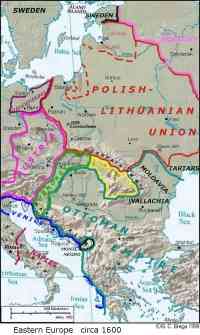 |
Two Thousand Years of the Modern Era in Eastern Europe Part 4: 17th to 19th Centuries - Ascendency of Austria, Prussia and Russia. |
Bill Biega's History Essays |
|
Biega Home Page
Consulting Using special characters. East Europe Cities, Countries, Info. History Genealogy, History Essays Maps Cities, Countries, Historical Photo Gallery Places I visited Rydzyna Sailing all over the world Syrena Press 13 Is My Lucky Number Learning LINUX 
Contact us by Email |
Click on any illustration with colored border to see it full size. Then click on "Back" button to return to this page.
Contrary to popular belief, life under
Ottoman occupation
was not so terrible. Jews and Christians enjoyed greater religious tolerance than was the case in western Europe at the time. Most onerous was the taxation of non-Muslims and the cultural isolation from the new Renaissance of the west. For example, the monasteries continued to turn out beautiful religious art but it was frozen in the medieval style. It was necessary to convert, at least nominally, to Islam in order to own land or to bear arms. For this reason alone, many of the mountain chieftains and their clans in Bosnia and Albania converted, an action resented by their neighbors, with severe consequences hundreds of years later.
Following the rout of the Ottoman forces at Vienna, the Treaty of Karlowitz (1699) freed Hungary. However, now Hungary was entirely under Austrian Habsburg domination, which lasted until 1918. By cooperating with the Habsburg court, many of the Hungarian aristocracy enjoyed great privileges, among them the Prince Esterhazy family. The principalities of Wallachia and Moldavia maintained a degree of autonomy under Turkish occupation by paying tribute to the Empire. However, their rulers were subject to Turkish approval. During the early part of the 17th. century, Moldavia came under Polish rule, but then the Turks regained control. In the meantime Poland was involved in several wars. Briefly, in 1610, Polish forces occupied Moscow, and retained control ovr the province of Smolensk. Immediately afterwards the Turks invaded the south and were repulsed in the battle of Chocim, in which the Cossacks fought on the Polish side. Subsequently the Cossacks lead by the Ukrainian Bohdan Chmielnicki, assisted by the Turks, rebelled against Poland and caused devastation of south-eastern Poland. In 1654 the Cossacks recognized the souverainity of Russia over Ukraine, which effectively doomed any hope of Ukrainian independence. Sweden, under King Charles Gustav, together with Brandenburg under king Frederick Wilhelm, took advantage of Poland's weakness and invaded the country in 1655. The heroic defence of the Czestochowa monastery rallied the country and finally the invaders were defeated. But the long brutal wars had devastated the country. The last great Polish king was John Sobieski, under whom there was a brief revival at the end of the 17th. century. The 18th. century saw the rise of three new great powers in Central and Eastern Europe. The Habsburgs had established full control of Austria, Bohemia and Hungary (as well as the Netherlands and part of Italy). In 1701 Frederick III of Brandenburg assumed power as King of Prussia, which included Brandenburg and Silesia. In Russia Ivan the Terrible had already established control over the Khanates of the Tartars in the 16th. century. Peter the Great, at the beginning of the 18th. century, took control of the Baltic coast and attempted to modernize the Russian state. In the meantime Poland had become impotent. The Seym (parliament) had instituted a rule of "Liberum Veto" which meant that it needed only one negative vote to paralize the country, resulting in a succession of weak Saxon and Polish kings, elected under pressure of the Prussians and Russians. In 1772, Catherine the Great of Russia, Frederick II of Prussia and Maria Theresa of Austria each took large chunks of Polish territory. Too late the Polish nobility awoke to the danger and during the Four Year Seym passed numerous reforms, including the Constitution of May 3rd. 1791 (modeled on the American Constitution). In 1795 Poland ceased to exist as an independent nation in spite of a last ditch heroic battle of armed peasants lead by General Kosciuszko against the Prussian and Russian armies at Raclawice. At the same time the French Revolution overthrew and executed Louis XVI. This brief summary does little justice to the complex history of the 17th and 18th centuries. Please follow up on the many links to learn more. Return to Top of page. Return to History Table of Contents for other History Essays. |
|
Return to Home Page.
Last update May 2002 |
